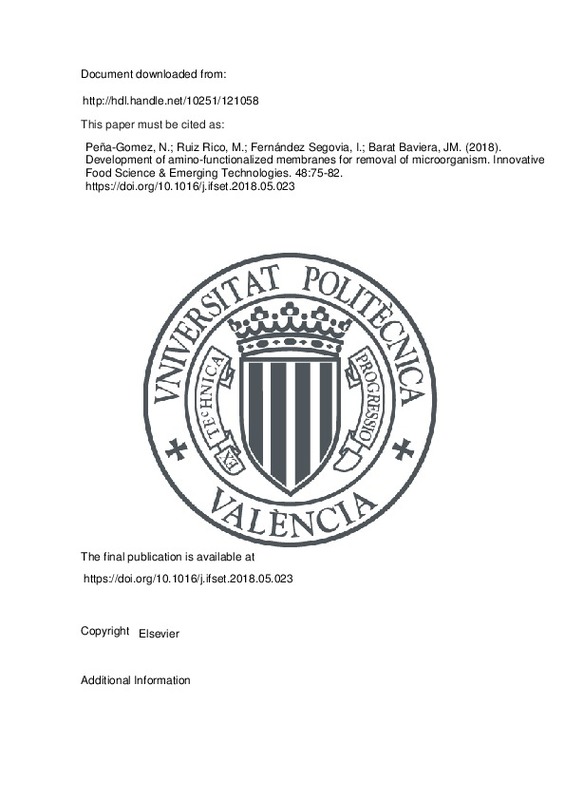JavaScript is disabled for your browser. Some features of this site may not work without it.
Buscar en RiuNet
Listar
Mi cuenta
Estadísticas
Ayuda RiuNet
Admin. UPV
Development of amino-functionalized membranes for removal of microorganism
Mostrar el registro sencillo del ítem
Ficheros en el ítem
| dc.contributor.author | Peña-Gomez, Nataly
|
es_ES |
| dc.contributor.author | Ruiz Rico, María
|
es_ES |
| dc.contributor.author | Fernández Segovia, Isabel
|
es_ES |
| dc.contributor.author | Barat Baviera, José Manuel
|
es_ES |
| dc.date.accessioned | 2019-05-24T20:02:09Z | |
| dc.date.available | 2019-05-24T20:02:09Z | |
| dc.date.issued | 2018 | es_ES |
| dc.identifier.issn | 1466-8564 | es_ES |
| dc.identifier.uri | http://hdl.handle.net/10251/121058 | |
| dc.description.abstract | [EN] Treatments to ensure water supply of an acceptable hygienic-sanitary quality is of vast importance. Among unconventional treatments, membrane technologies have recently stood out. Immobilization of antimicrobial compounds onto membranes can prevent fouling and lead to self-cleaning matrices. In this study, cellulose membranes functionalized with amines were developed to assess their capability to remove microbial contamination. Water samples with several levels of Escherichia coli inoculum were filtered through membranes, and different trials were run to check the system's effectiveness. The amino-functionalized membranes were able to filter water samples in a few seconds, and partially or completely remove the inoculated microorganism depending on the inoculum level. The amine-functionalized membranes displayed significant retention capacity in samples with high bacterial concentrations and were able to decontaminate water with low microbial load. Membranes can be reused with no apparent loss of efficiency. Hence, this study demonstrates the high potential of amine-functionalized membranes in drinking water treatments. | es_ES |
| dc.description.sponsorship | Authors gratefully acknowledge the financial support from the Ministerio de Economia y Competitividad and FEDER-EU (Project AGL2015-70235-C2-1-R). N.P.G. is grateful to Generalitat Valencia for her grant. The authors also thank the Electron Microscopy Service at the UPV for support. | es_ES |
| dc.language | Inglés | es_ES |
| dc.publisher | Elsevier | es_ES |
| dc.relation.ispartof | Innovative Food Science & Emerging Technologies | es_ES |
| dc.rights | Reconocimiento - No comercial - Sin obra derivada (by-nc-nd) | es_ES |
| dc.subject | Escherichia coli | es_ES |
| dc.subject | Filtration | es_ES |
| dc.subject | Immobilization | es_ES |
| dc.subject | Cellulose | es_ES |
| dc.subject | Polyamines | es_ES |
| dc.subject | Disinfection | es_ES |
| dc.subject.classification | TECNOLOGIA DE ALIMENTOS | es_ES |
| dc.title | Development of amino-functionalized membranes for removal of microorganism | es_ES |
| dc.type | Artículo | es_ES |
| dc.identifier.doi | 10.1016/j.ifset.2018.05.023 | es_ES |
| dc.relation.projectID | info:eu-repo/grantAgreement/MINECO//AGL2015-70235-C2-1-R/ES/SISTEMAS HIBRIDOS BASADOS EN SOPORTES BIOCOMPATIBLES PARA EL DESARROLLO DE ANTIMICROBIANOS A PARTIR DE SUSTANCIAS NATURALES Y LIBERACION CONTROLADA DE COMPUESTOS ALIMENTARIOS/ | es_ES |
| dc.rights.accessRights | Abierto | es_ES |
| dc.date.embargoEndDate | 2019-08-01 | es_ES |
| dc.contributor.affiliation | Universitat Politècnica de València. Departamento de Tecnología de Alimentos - Departament de Tecnologia d'Aliments | es_ES |
| dc.description.bibliographicCitation | Peña-Gomez, N.; Ruiz Rico, M.; Fernández Segovia, I.; Barat Baviera, JM. (2018). Development of amino-functionalized membranes for removal of microorganism. Innovative Food Science & Emerging Technologies. 48:75-82. https://doi.org/10.1016/j.ifset.2018.05.023 | es_ES |
| dc.description.accrualMethod | S | es_ES |
| dc.relation.publisherversion | https://doi.org/10.1016/j.ifset.2018.05.023 | es_ES |
| dc.description.upvformatpinicio | 75 | es_ES |
| dc.description.upvformatpfin | 82 | es_ES |
| dc.type.version | info:eu-repo/semantics/publishedVersion | es_ES |
| dc.description.volume | 48 | es_ES |
| dc.relation.pasarela | S\363952 | es_ES |
| dc.contributor.funder | Ministerio de Economía, Industria y Competitividad | es_ES |







![[Cerrado]](/themes/UPV/images/candado.png)

